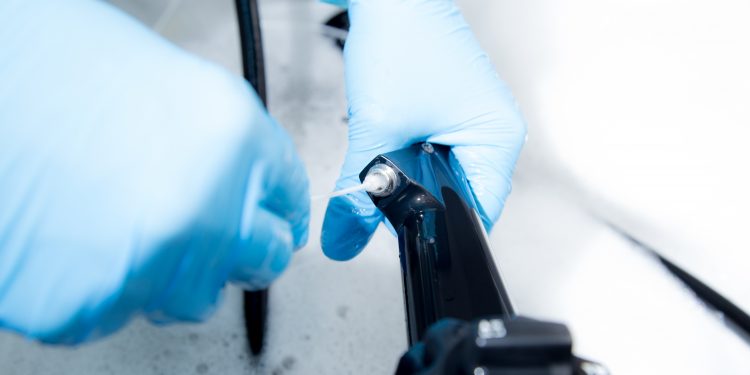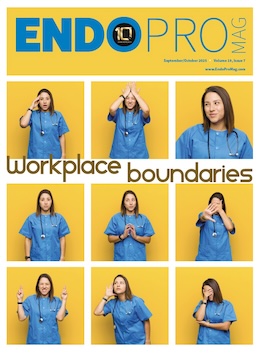Flexible endoscopes are complex devices that can be difficult to clean, therefore facility personnel responsible for overseeing reprocessing of flexible endoscopes should review reprocessing practices several times a year and ensure that processing personnel are adhering to the instructions of the endoscope, processing equipment, detergent and cleaning-supply manufacturers.
Cleaning in healthcare facilities is defined as “the removal, usually with detergent and water, of adherent clinical soil (e.g., blood, protein substances, and other debris) from the surfaces, crevices, serrations, joints, and lumens of instruments, devices, and equipment by a manual or mechanical process that prepares the items for safe handling and/or further decontamination” (ANSI/AAMI ST91:2021, p.4).
The Occupational Safety and Health Administration (OSHA) defines decontamination as “the use of physical or chemical means to remove, inactivate, or destroy bloodborne pathogens on a surface or item to the point where they are no longer capable of transmitting infectious particles and the surface or item is rendered safe for handling, use, or disposal” (29 CFR 1910.1030[b]).
The decontamination process involves two steps. The first and most important step is manual and/or automated cleaning. The second step is the application of a chemical disinfection or sterilization process. Although this sounds simple, each step has many components that must be performed correctly to ensure effective processing and the safety and health of employees, patients and the community.
Cleaning, followed by thorough rinsing, is the first—and probably the most important—step in the decontamination process. Without thorough cleaning, items may not be completely decontaminated. Patient deaths and/or infections have been traced back to flexible endoscopes that were inadequately cleaned. Meticulously performing all steps required for cleaning flexible endoscopes, components and accessories is essential to ensure they are safe for patient use.
Cleaning and rinsing remove rather than kill microorganisms. If contaminants such as blood, body fluids and tissue are left behind after cleaning, they can prevent disinfecting and sterilizing agents from contacting all surfaces of the endoscope and possibly create a breeding ground for microorganisms, making disinfection more difficult. And remember: Just because something looks clean doesn’t mean it is clean.
Personnel responsible for cleaning flexible endoscopes must wear appropriate personal protective equipment (PPE) to prevent exposure to contaminants such as blood, body fluids and tissue, as well as pathogenic and nonpathogenic organisms. Reprocessing technicians work in a wet environment and are also working with potentially hazardous chemicals such as detergents and disinfectants. The recommended PPE includes a Level 4 barrier gown, face shield or goggles, a fluid-resistant face mask, decontamination gloves, headcover and fluid-resistant shoe covers, per ANSI/AAMI ST91:2021.
Principles of Cleaning
Designated facility personnel must ensure that the manufacturer’s instructions for processing every type of endoscope used in the facility are available and followed. It is important for endoscope-processing technicians to understand that regardless of the facility or the items being reprocessed, the fundamental principles of cleaning remain the same. Certain general principles of cleaning apply to all items being processed. These principles include the following:
- The cleaning solution must contact every surface of the endoscope or endoscope accessory.
- There must be some type of physical action, such as friction, which enhances the cleaning process. Friction is the action of one surface or object rubbing against another. Friction is created by scrubbing, brushing and rinsing all surfaces of the endoscope during manual cleaning and by flushing and rinsing detergent through the lumens of the device.
The following nine factors have an impact on cleaning.
- Water quality
- Water temperature
- Cleaning activity of the detergents (also known as cleaning chemistry)
- Mechanical action
- Nature and design of the instruments or devices (e.g., simple or complex)
- Type of soil (e.g., blood versus fatty soil)
- Human factors/competence (e.g., training, complying with IFUs and using processing equipment correctly)
- Cleaning verification (checking and documenting the effectiveness of the cleaning process)
- Quality assurance (monitoring the cleaning process to ensure compliance with IFUs, facility policies and procedures, and applicable standards and guidelines)
When cleaning failures occur, one or more of these factors is involved.
It is important for all endoscope-processing team members to understand that disinfection and/or sterilization will not compensate for poor cleaning. The importance of performing adequate cleaning of flexible endoscopes cannot be overemphasized and is stressed in all professional guidelines and standards related to processing medical devices used for surgery and/or endoscopy. Further, the importance of obtaining and complying with the endoscope manufacturers’ IFU cannot be overstated.
The FDA had developed a guidance document, “Reprocessing Medical Devices in Health Care Settings: Validation Methods and Labeling Guidance for Industry and Food and Drug Administration Staff.” The purpose of this document was to guide medical-device manufacturers in creating and validating reprocessing instructions that, if followed, will ensure that their devices can be safely used for the purpose for which they were intended. Except for the specific regulatory or statutory requirements mentioned, this guidance document is not regulatory and is not legally enforceable; however, the IFU that manufacturers develop using this guidance document are recognized by the Joint Commission, AAMI, and other accreditation and professional organizations as providing a mechanism for the user to verify that the device can be safely reprocessed.
In addition to following manufacturers’ IFU, designated facility personnel must be able to verify the cleaning process recommended by a manufacturer. According to ANSI/AAMI ST58:2024, “Chemical Sterilization and High-Level Disinfection in Health Care Facilities (Annex N):” verification of a cleaning process consists of the following.
- Visual inspection combined with other verification methods to determine the cleaning of the external surfaces and the internal housing and channels of medical devices
- Testing the cleaning efficacy of cleaning equipment and
- Monitoring key cleaning parameters (such as the temperature)
Manufacturers provide such tests so the equipment can be tested efficiently without damaging the devices or necessitating recleaning of the device.
Quality Improvement
Designated facility personnel should ensure that each step in the cleaning process is fully verifiable through personnel training and through observation and that the process can be followed completely, accurately and without variation by all individuals who perform it; they must also provide process controls along with validation and verification methodologies that ensure adequate, consistent cleaning levels.
To define any facility process, designated facility personnel must develop written policies and procedures that identify the steps of the process. The policies and procedures should be based on published professional guidelines and should align with the validated processes described in the manufacturers’ IFU.
Designated facility personnel must also ensure that each employee completes an orientation program wherein the employee receives documented education and training about the tasks they will be performing at the facility and that the employee undergoes documented competency verification demonstrating their ability to perform the tasks correctly. After successfully completing their orientation, designated facility personnel should continue to provide education and training of employees as needed and should verify the competencies of each employee at least annually—or more frequently, as needed.
All personnel processing flexible and semi-rigid endoscopes should be certified in flexible-endoscope processing within two years of employment and maintain their certification throughout their employment (ANSI/AAMI ST-91, 2021).
The importance of implementing an effective cleaning process is underscored by accreditation surveyors who have been instructed to request that endoscopy technicians obtain the manufacturer’s IFU for a particular endoscope and demonstrate and/or describe the process that should be used to clean the device. This enables the surveyors to evaluate whether the employee is following the correct procedure to ensure the cleanliness and safety of the endoscope.
The manufacturer’s IFU for each device should include information about the recommended cleaning and/or disinfecting agents, cleaning implements, and cleaning methods that should be used, as well as instructions about how to disassemble the device for effective cleaning, if applicable.
If a manufacturer’s IFU are unclear, inadequate or contraindicated by best-practice recommendations from relevant professional organizations, designated facility personnel should contact the manufacturer for additional information and clarification.
Any information obtained from a phone call with a manufacturer’s representative or from a manufacturer’s sales representative should be followed by a written statement from the manufacturer confirming the information. It is not acceptable to rely on verbal instructions. All device manufacturers’ IFU should be readily available to processing personnel for reference. Failure to comply with the manufacturer’s IFU could void the manufacturer’s expressed or implied warranty and could result in high-level disinfection or sterilization failures. It is the responsibility of the processing professional to comply with the manufacturer’s IFU.
Summary
There are many more steps in the cleaning process and each one is important. It is up to the facility to ensure that staff are thoroughly trained and competent in the cleaning process. Routine observations and audits should be performed to ensure compliance with state policies and compliance with the device manufacturer’s current instructions for use (IFU). Some personnel who are responsible for cleaning do not recognize the importance of their job.
It is important to understand that the process of high-evel disinfection depends upon the disinfectant reaching ALL surfaces and channels of the device. If the device is not cleaned per the IFU, the disinfection process could be reduced or even nullified. That is simply not acceptable. Although not glamorous, your job is critical to good patient outcomes. The patient depends on you to do the right thing.








